SEE, SAY, DO SOMETHING Encourages Students Of Dallas ISD To Become Situationally Aware
Craig Miller, chief of police for the Dallas Independent School District Police Department, had moments earlier finished addressing a crowd of 6,000 mostly students sprinkled with educators and administrators at the American Airlines Center in Dallas at a community outreach program involving the arena, school district, and IAVM, when he commented on just how essential and impressive the event was.
Then, he added, in a somber tone, “It’s kind of ironic we are doing this right after what happened last Friday.”
That day, of course, was when a student at Santa Fe High School near Houston unleashed a volley of shots into a classroom that resulted in the deaths of 10 individuals and wounded several more. The student voluntarily surrendered and is in custody.
Titled, SEE, SAY, DO SOMETHING, IAVM and Director of Education Mark Herrera brought together a diverse range of presenters from various backgrounds to share with students over the course of more than two hours the importance of 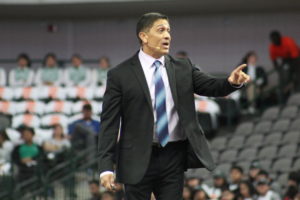 boldly speaking up when anything is suspicious. It is a refrain that is common and certainly not novel, but a refrain that cannot be pushed enough at a time when data validates the troubled times that have plagued schools since Columbine on April 20, 1999. In fact, a show of hands in the crowd revealed that most were not even born when Columbine took place and know about it only by what they hear and read.
boldly speaking up when anything is suspicious. It is a refrain that is common and certainly not novel, but a refrain that cannot be pushed enough at a time when data validates the troubled times that have plagued schools since Columbine on April 20, 1999. In fact, a show of hands in the crowd revealed that most were not even born when Columbine took place and know about it only by what they hear and read.
Herrera noted that the United States holds the unwanted distinction of having the most active shooter events with 21 such incidents already recorded at schools in 2018.
“Students had knowledge of 80% of the school shootings,” Herrera said. “These aren’t just sudden events. These are talked about in advance on social media, in the cafeteria. Over 90% of students planned the attack in advance.”
Whose Responsibility?
Chief Miller looked out at the sea of students that his department represents and implored their help.
“Our mission is to work with the campus administration,” he said. “Arrests are not our goal, but when we are challenged with situations we have to do often what we don’t want. Major change comes as a result of a major crisis. Columbine changed the way we respond. Then 9/11 changed forever how we do things. Sandy Hook (elementary school shooting in Connecticut on December 14, 2012, in which a shooter killed 26 people) brought about incredible changes in our schools and how we protect them.”
Chief Miller noted traveling to Parkland, Florida, 11 days after an attack on February 14 at the high school there in which 17 people were killed by a shooter. “You realize how personal this is now for people,” he said.
“Each of you in this crowd has a job to do,” he added. “Our job is to provide a safe learning environment for you. Your job is to supply information.”
Before addressing the crowd on the topic of Active Shooter – Making Prevention a Reality, John Skillestad, FBI Supervisory Special Agent, Office of Partner Engagement Violence Reduction Unit, Active Shooter Program, echoed much of Chief Miller’s theme.
“We cannot predict active shooters, but we can prevent them,” he said. “There are ways to prevent an active shooter. It’s not by looking at an individual and saying, ‘Oh, this person looks like an active shooter. I can tell by the way he’s dressed or she’s dressed.’ It’s all based on behavior. The behavioral aspects of what they do to share information out there that is basically a cry for help.”
It is a cry that often ends up being acted out and has dire and often deadly consequences.
“They are doing things unconsciously,” Skillestad said. “They may do it in writing, they may just go by their actions and showing that, hey, I am going down a pathway that people need to know that is not the pathway of normalcy.”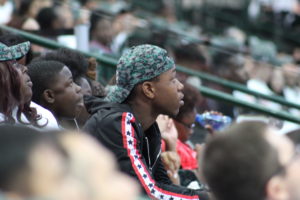
Again, Skillestad cautioned against making blanket summations of individuals, even though cues and hints get dropped along the way by the perpetrator. Such was the case at Santa Fe where the killer proudly displayed a “Born to Kill” shirt on social media.
“If this is something that he has never worn before to school or other behavior like that, then perhaps,” he said. “What we see is a lot of people will say, well, violent video games are the root cause of this. Well, how many kids play violent video games? Violent music where everybody listens to Marilyn Manson or whoever? Are they active shooters? No. It’s just part of the overall makeup of these individuals. What we believe they have is some type of deep-seeded angst for whatever reason. They were picked on, they felt slighted by not being chosen for an academic team or an athletic team. They just don’t feel like they are part of the community.
“My message is that each and every one of us, not only the students and not only the teachers but each and every member of the community, has to have the fortitude to stand up to someone who’s a bully or is picking on someone and saying that we are not going to have that. Then put it on those in positions of responsibility to make it incumbent on them to stop this. It may work in some situations and it may not, but if we don’t do anything nothing is going to change.”
Skillestad said that individuals need to be “upstanders as opposed to bystanders.”
“We don’t want people watching and saying, oh, isn’t that nice? We want people to react and respond and be a proactive force in the community.”
Addressing Vulnerabilities
Scott Breor, director, Protective Security Coordination Division with the Department of Homeland Security, leads a group that looks at the vulnerabilities within soft targets. Schools fall into that category.
“If you think about a facility or a venue where there is a large gathering of people, you often have an openness that schools have, that our churches have, vulnerabilities that can be exploited,” he said. “You could look at a school because it does have students populated, it does have open access to some extent. Newer constructed schools are better positioned to limit access with access controls, but schools typically have a vulnerability that can be exploited.”
Breor said he really had just one main message to implore the students, and that is to get involved.
“They need to assist whether it is a suspicious activity that another student might exhibit,” he said. “Think about the 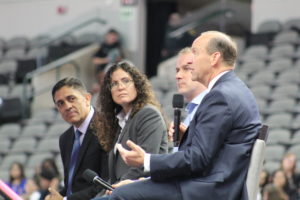 actions that are available to you if you were to hear a gun shot … if a gun shot went off in this room right now, where are the exits? Did you even think about that as you walked into this room?”
actions that are available to you if you were to hear a gun shot … if a gun shot went off in this room right now, where are the exits? Did you even think about that as you walked into this room?”
Breor emphasized that while students can be eyes and ears, the professionals are on the scene for a reason.
“Students don’t need to become security professionals but they need to get a level of awareness within the environment they are in,” he said.
The spectrum of speakers also included Cheryl Shannon, Dallas County District Judge, who spoke about the consequences of words, Dr. Tamara Madensen, UNLV Professor of Crowd Dynamics, who spoke on that topic, and Bob Kolasky, DHS Deputy Assistant Secretary, Office of Infrastructure Protection.
The school district was represented on a teen panel that included students Glenda Meyer, Molina High School, Alexandra Brooks, Woodrow Wilson High School, Reagan Ruffin, Skyline High School, and Lucky Lawhorn, Barack Obama Male Leadership Academy. The students took turns asking questions of another panel made up of some of the presenters.
In addition to the education, students got to enjoy performances by dance teams of the Dallas Mavericks and Dallas Stars, while the drum lines from Bryan Adams High School and Carter High School energized the crowd.
Dallas Maverick Dwight Powell opened things by welcoming the students. “We remember our middle school and high school days,” he said. “Take and protect your future as well as your classmates. It is exciting to see the good work you are doing for your community.”
Breor noted that this rollout at an IAVM member venue is a great start and one that has potential for future growth throughout the country.
“As this model possibly rolls out to other localities and metropolitan areas, our department wants to further along this relationship with IAVM so we can be not only supportive but also take part to show that there really are no lines where something belongs to this department, something belongs to the community, this belongs to the school district. We are all part of a community and we all need to address this for our schools.”
In Her Own Words: Rose Mary Ward Shares About Her Beloved Husband, Ray
February 7, 2019 would have marked the 60th wedding anniversary of Ray and Rose Mary Ward. The milestone was not lost on Rose Mary, who had many memories to share during a phone interview about her beloved husband, Ray, who passed away on May 2. It is too easy to toss around words like legend, icon, and giant, but Ray Ward was truly all of those and so much more to an industry he loved and to hundreds of people he groomed and mentored to likewise excel in the profession of public assembly venue management. In her own words, Rose Mary reveals so much about her husband in his prime as well as some poignant reflections as he was moved to a memory care facility in June 2017 to gallantly fight Alzheimer’s and congestive heart failure.
On Ray’s impact on people:
He didn’t talk much about mentoring. He would tell me about these special people and their qualities and how he admired them, but he didn’t talk about 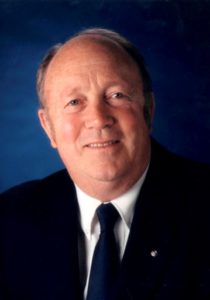 how he helped anybody. I knew he did, though, because I would run into people at a conference or something and there would always be a group of people in a room that came up to him and I just sat back and kind of watched. He loved the IAVM. He truly, truly loved it. He loved seeing it grow from when he went in and how much it had changed. It was amazing.
how he helped anybody. I knew he did, though, because I would run into people at a conference or something and there would always be a group of people in a room that came up to him and I just sat back and kind of watched. He loved the IAVM. He truly, truly loved it. He loved seeing it grow from when he went in and how much it had changed. It was amazing.
Everyone gravitated toward Ray. Even our sons’ friends would call him in the middle of the night, not their own father. Jonathan is our oldest, and then Stephen is the middle, and Daniel is the youngest. They all relied on their dad.
On Ray as a lifelong learner:
He was always reading and always learning. He remembered everything. He was always educating himself. There is always something you can learn. One of his sayings was that when your mouth is moving, you’re not learning anything. That was aimed at me!
On the passing of Ray’s close friend Bill Cunningham, who deceased on May 8 and was responsible for hiring Ward at the Oakland-Alameda County Coliseum:
Bill was the one that hired Ray when the Coliseum was just a hole in the ground. Those two were very close and had the same values with family so important. Bill had done a number of things so that Ray could coach the boys’ teams and stuff where he would come home to coach the team and then go back to work the Coliseum at night. He passed away just a week after Ray. Both of them always talked about the Coliseum and the different people in there.
On the disease that took over her husband:
Ray had Alzheimer’s and congestive heart failure. With Ray it was like with my mother. You lose a little by little. The man that died was not Ray. It was, but it wasn’t. He would hate what had haopened to him. It was like a relief. He wasn’t suffering any more. I have that I can look at and smile and say, you’re happy now. You’re not suffering. I do have the boys, my three boys, and they’re just wonderful.
It’s like a part of you. Every day you seem them going a little bit more. The disease took over his brain. You know, though, he remembered so many things about the Coliseum. How many years ago was that? He could remember all that. I was sharing with Brad (Mayne, IAVM president and CEO) how in the home Ray wasn’t about to do any of their little arts and crafts or little exercise groups.
I got him a big tablet and pen and pencil. He would watch and make lots of notes. He got so he wrote so little and tiny that you could barely read it. He would say, I’m telling you people you’re very inefficient at what you do. He was making all kinds of notes of how this place could be a real money make. Then the other thing he would do … they would call me in the middle of the night and I told them to quit doing that, but they would call me. He knew how to set off all their alarms. He would watch them setting things and stuff and then he would hide in a little alcove and watch them run down and turn them off and after walking back they’d see him and they’re laughing.
I said, I’m sorry. I started laughing, but you have to see the humor in this. I told them he is absolutely bored. You have to find jobs. He likes solving problems and he he likes working. He doesn’t know recreation and how to deal with that. He was the only one they called Mr. Ward or sir. Everybody else was by their first name. They knew he was not used to taking orders. He was used to giving orders. They would always ask him what do you think we should do today, or how should we handle this? They might make a suggestion and he might follow their suggestion. They did not tell him what to do.
I said, this is the real Ray Ward. At the end hospice came down. The nurse from the memory care had called them. He would go on plateaus but all of a sudden he just took a nosedive. I talked to the hospice doctor and he said that 99% of the time I can’t say absolutely for sure, but when it happens this quickly then it is that they usually have had a stroke. In a matter of about three weeks he went from me going in and I would get one of their soft ballsand would throw it to him. My son was there one time and he said, boy, he remembers exactly how to catch that ball and how you bat it back. He did not miss. He went from being like that to I would take a spoonful of something and put it in his mouth and asked if he could eat it. He would just keep his mouth open. He just stared and couldn’t even eat.
I got a phone call at 6 in the morning. They said they found him and he had died. I said I would be there as soon as I can. I took care of a few things and made a couple of phone calls. I went down there and went straight to him. I didn’t see anybody else. I looked at him and he was so peaceful looking. His face was always kind of scrunched up and he had a lot of pain from the heart disease. There was like a little smile. His mouth was open but it sort of turned up. I went down to the nurse and she said his hands were crossed across his chest. He looked to her like he was smiling. They closed his mouth and said his whole face was so relaxed and so peaceful. She said he just went in his sleep like that. That’s how I want to go.
On plans to honor her husband:
When my younger sister passed away, we had at my niece’s a little family get-together, memorial. That was about four years ago. On the way home, Ray said, That’s what I want. I don’t want any big-to-do thing. I just want the family or those real close. Just do it at the home. I am going to respect his wishes and that’s what I’m doing. It’s going to be in June. Just kind of a family thing. We are going to do an Irish wake and tell stories about dad, and uncle Ray. He was very important in the family, like the Godfather. It will be a happy time.
We were 20 years in Granite Bay, just outside of Sacramento. I just moved further up the mountain here. I checked with the boys and two of them said he told him the same thing. It was his wish.
Bill Cunningham Service Set For May 18
William Arthur “Bud” Cunningham, of Manteca, California, born on June 29, 1928 in Newark, New Jersey, passed away peacefully at age 89 on May 8, 2018.
William is survived by his wife of 66 years, Mary Theresa Cunningham. Mary and Bud moved to Manteca in 2001 – after 37 years in San Leandro. Their life together was filled with adventure, excitement, love, and laughter.
He is also survived by his five children: son, Bill Cunningham (Joanne); daughters, Mary Anderson (Dennis), Kathy Pietrunti (John), Nancy Calderon 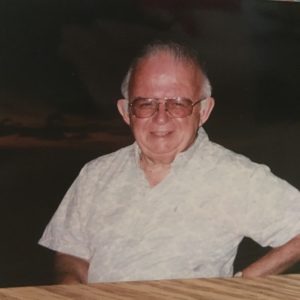 (Phillip), and Theresa Stevens (James); seven grandchildren: Colleen Anderson Guidi (Scott), Michael Anderson, Stephen Pietrunti (Maria), Megan Pietrunti, Lindsey Calderon, Nicole Stevens, and Andrew Stevens; and two great-grandchildren: Ryan Guidi and Mia Guidi.
(Phillip), and Theresa Stevens (James); seven grandchildren: Colleen Anderson Guidi (Scott), Michael Anderson, Stephen Pietrunti (Maria), Megan Pietrunti, Lindsey Calderon, Nicole Stevens, and Andrew Stevens; and two great-grandchildren: Ryan Guidi and Mia Guidi.
William is a graduate of Panzer College, East Orange, N.J., and completed graduate business studies at The Wharton School, University of Pennsylvania.
He was in the Facility Management industry for most of his career. He served at the Philadelphia Trade and Convention Center as an Assistant Director from 1957-1964; at the Oakland-Alameda County Coliseum Complex as General Manager until 1980; and Coliseum Consultants as the President until retiring in 1995. He was elected President of the International Association of Venue Managers (IAVM) from 1973-1974, then received the Charles A. McElravy award in 1978, the industry’s highest honor, for his contributions to the organization and profession. His career coincided with multiple championships for his beloved Oakland Athletics, Oakland Raiders, and the Golden State Warriors.
“Bill Cunningham will always be remembered for his passion for the profession of public assembly venue management, his consistent willingness to mentor anyone new to the field who expressed an interest, and of course, his terrific sense of humor,” said Bob Mayer, CVE, a long-time friend and also a fellow past IAVM president. “He helped and mentored me in many ways during my years on the Board with some special guidance, direction, and advice. His love of the Association was sincere and a part of his fabric. He will be missed.”
Friends and family can pay their respects at the memorial service on Friday, May 18 from 11:00 to 12:00 p.m. at St. Joan of Arc Catholic Church, 6404 Washington Street, Yountville, California, 94599. In lieu of flowers, donations can be made to charity in his memory.
For an article that speaks greatly to his work in the public assembly venue profession, click here.
Los Angeles Convention Center Hires Nancy Walker As Vice President Of Sales & Marketing
The Los Angeles Convention Center (LACC), owned by the City of Los Angeles and managed by AEG Facilities, announced the appointment of Nancy Walker as the new vice president of sales and marketing.
Nancy joins the LACC with more than 20 years experience in the events and trade show industry, most recently as the director of sales, North America at Reed  Travel Exhibitions. Prior to her work as director of sales, Walker was the vice president and associate publisher at Tradeshow Week Magazine.
Travel Exhibitions. Prior to her work as director of sales, Walker was the vice president and associate publisher at Tradeshow Week Magazine.
“Nancy will be a great addition to the outstanding LACC sales and marketing team,” said Ellen Schwartz, assistant general manager at the LACC. “Her expertise and fresh perspective will strengthen our Sales and Marketing Department and the facility as a whole.”
Birmingham Lands Sports Commissions Convention
Birmingham is set to host a convention of sports event professionals, and it could mean millions of dollars in future bookings for the greater Birmingham area.
The National Association of Sports Commissions announced at their meeting this month in Minneapolis that Birmingham has won the bid to host their 2021 Annual Symposium.
As the only non-profit trade association in the U.S. sport tourism industry, the NASC is considered the most essential resource for sports commissions, sports destinations, vendors, and sports event owners. Nearly 800 member organizations lead, manage and execute sports events of all sizes.
“Hosting the NASC will be a rare opportunity for us to promote area sporting facilities and to meet one-on-one with industry professionals who plan sports events,” said J. John Oros, Jr., Greater Birmingham Convention & Visitors Bureau president and CEO. “From the Birmingham Crossplex and the Hoover Metropolitan Complex to the BJCC Legacy Arena, we have a lot to show off.”
More than 1,000 attendees are expected for the 2021 Annual Symposium, resulting in about 4,000 room nights. Direct visitor spending during the event is estimated by NASC officials to be more than $1 million.
“While the economic impact of this convention is important, it is bookings in the aftermath that can benefit us for years to come,” Oros said.
Do you want to receive a Front Row News weekly digest?
Categories
- Allied (861)
- Architecture (147)
- Arenas (747)
- Career (897)
- Convention Centers (895)
- Education (623)
- Events (1,544)
- Food & Beverage (193)
- Foundation (113)
- Guest Experience (1,496)
- Industry News (2,270)
- Leadership (1,888)
- Marketing (150)
- Membership (2,000)
- Music (213)
- Performing Arts Centers (454)
- Professional Development (409)
- Research (127)
- Safety & Security (442)
- Sports (763)
- Stadiums (608)
- Student (159)
- Technology (516)
- Ticketing (92)
- Touring (82)
- Trends (364)
- Uncategorized (743)
- Universities (218)
- Video (25)
- Young Professional (198)
Twitter Feed
- Twitter feed loading
Recent Posts
- Venuworks and ATG Entertainment Selected to Manage Fresno Convention and Entertainment Center
- Seattle Convention Center Announces Strategic Leadership Appointment and Growth Initiatives for 2026
- Peggy Daidakis Humbly Made Convention Center History
- Welcome to Our Newest Members
- New Member Benefit! IAVM Partners with Advantage Training to Elevate Staff Readiness and Guest Experience
Categories
- Allied
- Architecture
- Arenas
- Career
- Convention Centers
- Education
- Events
- Food & Beverage
- Foundation
- Guest Experience
- Industry News
- Leadership
- Marketing
- Membership
- Music
- Performing Arts Centers
- Professional Development
- Research
- Safety & Security
- Sports
- Stadiums
- Student
- Technology
- Ticketing
- Touring
- Trends
- Uncategorized
- Universities
- Video
- Young Professional
Archives
- December 2025
- November 2025
- October 2025
- September 2025
- August 2025
- July 2025
- June 2025
- May 2025
- April 2025
- March 2025
- February 2025
- January 2025
- December 2024
- November 2024
- October 2024
- September 2024
- August 2024
- July 2024
- June 2024
- May 2024
- April 2024
- March 2024
- February 2024
- January 2024
- December 2023
- November 2023
- October 2023
- September 2023
- August 2023
- July 2023
- June 2023
- May 2023
- April 2023
- March 2023
- February 2023
- January 2023
- December 2022
- November 2022
- October 2022
- September 2022
- August 2022
- July 2022
- June 2022
- May 2022
- April 2022
- March 2022
- February 2022
- January 2022
- December 2021
- November 2021
- October 2021
- September 2021
- August 2021
- July 2021
- June 2021
- May 2021
- April 2021
- March 2021
- February 2021
- January 2021
- December 2020
- November 2020
- October 2020
- September 2020
- August 2020
- July 2020
- June 2020
- May 2020
- April 2020
- March 2020
- February 2020
- January 2020
- December 2019
- November 2019
- October 2019
- September 2019
- August 2019
- July 2019
- June 2019
- May 2019
- April 2019
- March 2019
- February 2019
- January 2019
- December 2018
- November 2018
- October 2018
- September 2018
- August 2018
- July 2018
- June 2018
- May 2018
- April 2018
- March 2018
- February 2018
- January 2018
- December 2017
- November 2017
- October 2017
- September 2017
- August 2017
- July 2017
- June 2017
- May 2017
- April 2017
- March 2017
- February 2017
- January 2017
- December 2016
- November 2016
- October 2016
- September 2016
- August 2016
- July 2016
- June 2016
- May 2016
- April 2016
- March 2016
- February 2016
- January 2016
- December 2015
- November 2015
- October 2015
- September 2015
- August 2015
- July 2015
- June 2015
- May 2015
- April 2015
- March 2015
- February 2015
- January 2015
- December 2014
- November 2014
- October 2014
- September 2014
- August 2014
- July 2014
- June 2014
- May 2014
- April 2014
- March 2014
- February 2014
- January 2014
- December 2013
- November 2013
- October 2013
- September 2013
- August 2013
- July 2013
- June 2013
- May 2013
- April 2013
- March 2013
- February 2013
- January 2013
- May 2012
- March 2012
- December 2011
- November 2011
- October 2011
Recent Comments
- Frank Bradshaw, Ph.D., CVE on John Meyer, CVE, a Tireless Advocate of Certification for Venue Professionals, Has Died
- Neil Sulkes on Hilary Hartung, Friend to Many in Venue Marketing, Has Left Us
- Jason Parker, CVE on The Devastation of Hurricane Helene and How We Can Support One Another
- Larry Perkins on Touhey Testifies Against Speculative Ticketing Before Congressional Subcommittee
- Peter Secord on Major Players for Planned Elkhart Amphitheater Were in the Mix at VenueConnect
